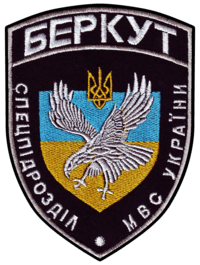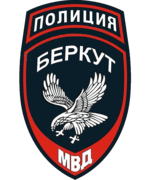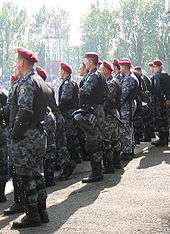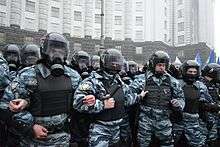Berkut (special police force)
The Berkut (Ukrainian: Бе́ркут, "golden eagle"; Russian: Бе́ркут, Byerkut) was the Ukrainian system of special police (riot police) of the Ukrainian Militsiya within the Ministry of Internal Affairs.[4][5] The agency was formed in 1992, shortly after the dissolution of the Soviet Union, as the successor to the Ukrainian SSR's OMON.
| Special Detachment of Public Security Militsiya "Berkut" (Ukrainian: Cпеціальний підрозділ міліції громадської безпеки «Беркут») | |
|---|---|
 Former emblem of the Berkut (1992–2014) | |
| Active | 1992–present |
| Country | |
| Type | Gendarmerie, riot police |
| Role | Tactical Law Enforcement Riot Control Domestic counter-terrorism Security of public order Hostage rescue |
| Size | 400 (Russia)[3] |
| Part of | National Guard of Russia (2016–present)A |
| Engagements | 2014 Ukrainian revolution 2014 Crimean crisis |
| Insignia | |
| Berkut emblem (Russia) |  |
Initially specialized in fighting organized crime, Berkut transitioned into a gendarmerie used by the Ukrainian Militsiya for public security, operating semi-autonomously at the local or regional level, and the term "Berkut" came to be used for any professional special police unit in Ukraine. Following the 2014 Ukrainian revolution, Berkut has a history of illegal activities against Ukrainian citizens, such as racketeering, terrorism, physical violence, torture, anti-Ukrainian sentiment, voter intimidation against those who would elect non-Yanukovych candidates, and violence against protesters during Euromaidan and the Orange Revolution.[6][7] The new government held Berkut responsible for most of the Heavenly Hundred civilian deaths, and acting Ukrainian Interior Minister Arsen Avakov signed a decree that dissolved the agency, which was replaced with the National Guard of Ukraine.[8][9][10]
Crimean Berkut
In March 2014, Berkut units stationed in the Autonomous Republic of Crimea and Sevastopol defected to the Russian Ministry of Internal Affairs during the annexation of Crimea by Russia, after the territories were approved as federal subjects.[1][2][3][11][12]A Berkut effectively became an agency of Russia when units were allowed to preserve their old name, and now serve within the National Guard of Russia as the gendarmerie for Crimea.[3][11]
Etymology
Berkut means golden eagle (Aquila chrysaetos) in the Ukrainian language, referring to a raptor historically associated with falconry on larger mammals, particularly foxes. It is probably a Turkic loanword, compare Chagatai (börküt), Kazakh "бүркіт" (bürkit), Tatar "бөркет" (bөrket), Bashkir "бөркөт" (börköt), Kyrgyz "бүркүт" (bürküt), Uzbek "burgut".
Ukraine

History
The Berkut was founded on January 16, 1992, three weeks after the dissolution of the Soviet Union, as the "Berkut" Separate Special Assignment Unit(s) of Militsiya to serve the newly independent Ukraine as the replacement of the Ukrainian SSR's branch of the Soviet OMON (Special Purpose Police Unit). The order to organize the OMON in the Ukrainian SSR had been issued on 28 December 1988, over a year after the establishment of the Soviet OMON back in 1987 and almost three months later after the issue of official order on October 3, 1988.[13] The first OMON units in Ukraine were formed in Kiev, Dnipropetrovsk, Odessa, Lviv and Donetsk and were based on selected units of Soviet Internal Troops of the Soviet Ministry of Internal Affairs. After Ukrainian independence, it was decided to organize OMON units in every oblast (province) center as part of the Ukrainian Ministry of Internal Affairs. The new agency was fully implemented by the start of 1993, and inherited Ukrainian OMON's functions, including responsibility for high-risk police operations including hostage crises and riot policing, but primarily as a quick reaction force with a focus on combating organized crime.
Organization

The Berkut was a reserve unit of the Ministry of Internal Affairs (MVS) and subordinates to the regional (oblast) departments of the MVS. Until 1997 it was under the direct supervision of HUBOZ (Chief Directorate in Fight of Organized Crime). Due to formation of another quick reaction force unit Sokil (Falcon) under HUBOZ, Berkut was later reassigned under the supervision of the Directorate of Public Security of the MVS. The main duty of the unit was the security of the general public and enforcement of civil order, especially during mass public events (demonstrations, parades, sport or concert events, etc.), or in places of increased criminal activity as part of the fight against organized crime. The Berkut have also been assigned to provide protective custody of certain individuals, such as witnesses in criminal trials.
Berkut members were paid 1.5-2 times more than the average Ukrainian police officer.[14] Depending on the region, the Berkut's units ranged in manpower from 50 to 600. Also depending on its dislocation, the unit could have been commissioned as a company or regiment. As of January 2008, the force consisted of two regiments, six separate battalions, and 19 companies totaling 3,250 members.[15] One of the regiments is located in Kiev, while another one is stationed in Crimea. During the Euromaidan protest movement Berkut members from more the pro-Euromaidan Western Ukraine complained to the media that they were "mistrusted" by top commanders.[14]
The Berkut militia were distinguished by their maroon berets (also known as "krapovy beret"), an honorary headgear. Standard Berkut equipment includes AKM assault rifles, PK machine guns, Dragunov SVD sniper rifles, UAZ-469 jeeps and the BTR-70 armoured personnel carriers.[14] Some units are issued with the SPG-9 recoilless rifle and RPG-7 on a need basis.
Criticism
Political violence
The Berkut increasingly developed a reputation for engaging in political-related violence, including acts of police brutality and extrajudicial punishment against anti-government protesters, activists, and voters.
On 25 June 1995 during mass riots of Crimean Tatars who started so called "turf war" against Crimean gang "Bashmaki", policemen of "Berkut" from Poltava on the highway near Sudak, (Autonomous Republic of Crimea) open fire to kill from automatic weapon which resulted in seven people were wounded and two were killed.[16]
On 18 July 1995 Berkut was involved in partially successful attempt to prevent burial of Patriarch Volodymyr (Romaniuk) on territory of St.Sophia monastery (surrounds the Saint Sophia's Cathedral).[17] That day is known in Ukrainian history as the Black Tuesday.
On 24 August (Independence Day of Ukraine) 1998 Berkut participated in dispersing of picketing of miners in front of the Luhansk "House of Soviets" (administration building of Luhansk regional government and legislation).[18] The picketing of miners from Krasnodonvuhillia was caused by salary indebtedness for last 2.5 years.[18] At that time Luhansk Oblast was governed by Oleksandr Yefremov and Viktor Tikhonov.[18]
In 2004 and 2005, Berkut teams participated in many actions of Leonid Kuchma's government against the opposition during the Orange Revolution. Former Ukrainian president Viktor Yanukovych has been accused, including by Amnesty International, of using the Berkut to threaten, attack, and torture Ukrainian protesters. Upon coming to power, Yanukovych had reversed oversight measures established during the Yushchenko administration to curb Berkut abuse of citizens, whereupon the special force "upped its brutality."[6]
Euromaidan
On 30 November 2013, Berkut units in Kiev violently dispersed protesters during the Euromaidan protest movement, and have since been involved in many other instances of brutality in suppressing the movement. On 27 January 2014, the Ministry of Defense announced sharp pay raises for military personnel,[19] and the Cabinet of Ministers adopted a secret resolution to increase the size of the Berkut force sixfold to 30,000; they would also be given more power and a reserve fund would be set aside for additional ammunition.[20] Former head of Security for the Ukrainian president, General Viktor Ivanovich Palivoda, stated in early February 2014 that those officers standing in the front lines of riot control received pay bonuses, and that they received bonuses for capturing protesters, included added years of service.[21]
Citizen disenfranchisement
The Organization for Security and Cooperation in Europe confirmed witness accounts of voters being blocked from access to polls and being attacked along with local election officials who tried to frustrate the Berkut's practice of falsifying voters' ballots in favor of Yanukovych's Party of Regions candidates. Individual cases have been reported of citizens grouping together and fighting back against the Berkut in order to preserve election integrity and results.[7]
Anti-semitism
Bernard-Henri Levy noted that in its last days before the end of the 2014 Ukrainian revolution and the Berkut's disbandment, on its website the group accused Euromaidan leaders of being Jewish; one accused was Ihor Kolomoyskyi. Berkut had posted a picture with a superimposed Star of David and Swastika in order to depict an alliance of Nazis and Jews against pro-Russians in Eastern Ukraine.[22]
Specific incidents
Writing in Business Insider in February 2014, Harrison Jacobs noted: "The Berkut ... has had a long history of brutality, abuse, torture, and other measures in service of whatever political regime is in control of Ukraine."[6] According to Ukraine political expert Taras Kuzio in November 2013, in recent years the force had been increasingly used to intimidate anti-government demonstrators and to influence the electoral process.[7]
- 23–25 June 1995 — Assaulted Crimean Tatars near Sudak (Crimea) and helped criminals to escape angry crowd[23]
- 18 July 1995, "Black Tuesday" — Prevented burial of Patriarch Volodymyr (Kiev)[24][25]
- 24 August 1998 (Independence Day) — Violently dispersed peaceful protest of coal miners (for not having been paid for two and a half years) in Luhansk[26] (governor of Luhansk Oblast - Oleksandr Yefremov)
- November 2000 — March 2001, Ukraine without Kuchma — Protected government from angry crowd
- 19 August 2013 — Attacked Parliamentarians during the 2013 Kiev political protests near city hall
- Beginning on November 22, 2013, attacked protesters of the Euromaidan
- 23 January 2014 — Kidnapped Alexandra Haylak, a 22-year-old volunteer of the Euromaidan medical service, stripped her of all identification, and left her in the woods near Vyshhorod.[27]
- 23 January 2014 — Opposition member of Ukraine's parliament Andriy Parubiy reported that the Berkut was altering standard -issue stun grenades, making them killing devices by wrapping them with nails and other shrapnel and using them against Euromaidan protesters. Parubiy showed reporters samples of the altered weapons.[28]
- On 23 January 2014, Berkut officers arrested protester and Zaporozhian Cossack Mykhailo Gavrylyuk.[29] In temperatures approaching -15 °C, Berkut officers beat Gavrylyuk with blows to his head and torso, then stripped him naked and forced him to the ground.[29][30] Whilst he was on the ground, Berkut officers put their feet on his head, as association football players would place their feet on a ball, and photographed themselves.[30] A video was later uploaded to YouTube showed, in scenes reminiscent of the Abu Ghraib prisoner abuse scandal Berkut officers posing for photographs with the naked Gavrylyuk.[31][32] In a further attempt to humiliate him, Berkut offices forced Gavrylyuk to hold an ice-axe and attempted to make him proclaim, "I love Berkut".[33] The video went viral and, apart from making Gavrylyuk a symbol of Euromaidan, drew an apology from Interior Minister Vitaliy Zakharchenko.[30][33] Gavrylyuk revealed at a press conference after the incident that the Berkut officers also cut a couple of strands of the traditional Cossack forelocks (oseledets) from his head.[33]
Dissolution

On 25 February 2014, acting Ukrainian Interior Minister Arsen Avakov signed a decree on the dissolution of the Berkut, as by then the agency had become synonymous with police brutality for many pro-Euromaidan protesters and sympathizers.[9][34][35][14] The Berkut was dissolved only four days after the opposition forces that had supported Euromaidan (including Avakov) had taken control of the Ukrainian government, and replaced with the restored National Guard of Ukraine on 13 March 2014.[12] Many pro-Ukrainian Berkut servicemen opted to join the National Guard of Ukraine, which is partly composed of former Euromaidan activists, and began fighting alongside the regular Ukrainian Army against pro-Russian separatists in the concurrent War in Donbass.[36]
Russia
History
Five days before the dissolution of Berkut by the Ukrainian government, Russia began annexation of the Crimean peninsula and seizing control of the Autonomous Republic of Crimea and Sevastopol. A sizeable Berkut unit had been stationed in Crimea, and took part in maintaining public order during the 2014 Ukrainian revolution and Euromaidan.[3] Media and Euromaidan demonstrators had accused Berkut of being excessively violent during these events.[37][38][39] On 26 February 2014 the newly appointed Russian de facto mayor of Sevastopol, Alexei Chaly, announced the formation of a new Berkut special police force "in order to maintain public order in Sevastopol, to prevent unlawful acts of provocation, riots and looting." [40] Chaly then offered asylum to former Berkut troops in Ukraine, saying "These people adequately fulfilled their duty to the country, have shown themselves to be real men, and are now abandoned to the mercy of this rabid pack of Nazis. For faithful service, today criminal cases are brought against them. At this difficult time our city needs decent men who could form the basis of self-defense groups, and in the future the municipal police. We are ready to provide for them if they join us in our struggle, and to offer safety to their families.”[41] On 28 February Russia started to issue pro-Russian Berkut members Russian passports in the city of Simferopol.[42] By 21 March 2014, the date the Republic of Crimea and Sevastopol were granted accession as federal subjects of Russia as a result of the referendum in Crimea, the Berkut units based in the territory were still active despite the agency being dissolved.[12]A[3][43][12]A Three days later, Russia announced that the Berkut units in the Republic of Crimea and Sevastopol would preserve their name and would be incorporated into the Russian Ministry of Internal Affairs.[3]
In June 2014, an armed pro-Russian separatist group fighting in Donetsk and Luhansk in the War in Donbass called the Donbass Veterans' Union claimed to be composed of "more than 1000" former Berkut officers and other former servicemen and police officers.[44]
On 5 April 2016, Berkut was transferred from the Russian Ministry of Internal Affairs to the newly-created National Guard of Russia.
Notes
- A.^ The status of Crimea and Sevastopol is currently under dispute by Ukraine and Russia; Ukraine and the majority of the world consider Crimea an autonomous republic of Ukraine and Sevastopol one of Ukraine's cities with special status, while Russia, on the other hand, considers Crimea a federal subjects of Russia and Sevastopol one of its federal cities.[45] Both are completely under Russian control.[12]
References
- , Information Telegraph Agency of Russia (24 march 2014)
- "сохранит свое название в составе органов МВД РФ". amicru. 25 March 2014. Retrieved 29 March 2014.
- Russian interior bodies created in Crimea and Sevastopol Archived 2014-04-07 at the Wayback Machine, ITAR-TASS (25 March 2014)
- Berkut arrived to defend Yanukovych's Mezhihirya from journalists. ictv. June 6, 2013
- Beaten up by Berkut neighbor of Yanukovych was recognized guilty and fined. 24tv. January 18, 2014
- Harrison Jacobs (27 January 2014). "Why Ukraine's Berkut Special Police Force Is So Scary". Retrieved 1 February 2014.
- Berkut Riot Police Used to Falsify Ukrainian Parliamentary Elections, The Jamestown Foundation (14 November 2012)
- Ukraine's new rulers disband riot police, Reuters (Feb 26, 2014)
- Head of Ukrainian Interior Ministry signs order to dissolve "Berkut" , Voice of Russia (25 February 2014)
- Аваков распустил "Беркут" : Новости УНИАН 26.02.2014 | 01:10
- Crimean Berkut police to preserve name as it incorporates into Russian Interior Ministry, ITAR-TASS (24 March 2014)
- Ukraine: Speaker Oleksandr Turchynov named interim president, BBC News (23 February 2014)
Ukraine protests timeline, BBC News (23 February 2014) - "MVD website, history 1986 - 1993". Retrieved 23 October 2014.
- Ukraine's Berkut police: What makes them special?, BBC News (25 February 2014)
- (in Ukrainian) МВС України ДЗГ МВС України 16.01.2008
- Volodymyr Prytula. A spark that almost burned down the Crimea (ИСКРА, КОТОРАЯ ЧУТЬ НЕ СОЖГЛА КРЫМ). The Mirror Weekly. 30 June 1995
- Near walls of the St.Sophia Cathedral in Kiev was buried Ukrainian Patriarch Volodymyr. Calendarium.
- Viktoriya Mamotyuk. Miner who burned down himself in sign of protest against the Berkut's attack people (Гірник спалив себе на знак протесту побиття людей "беркутівцями"). Vse. 14 December 2013
- Twitter / OS1954: Defence ministry announces 5:29 AM - 27 Jan 2014 from Westminster, London
- "EuroMaidan rallies in Ukraine (Jan. 26-27 live updates)". Kyiv Post. Retrieved 27 January 2014.
- Ukrainian top general: There is proof of russian intervention in Ukraine | Uriks.no Archived 2014-02-15 at the Wayback Machine
- Levy, Bernard-Henri (26 February 2014). "Ukraine's Revolutionaries Are Not Fascists". Daily Beast. Retrieved 28 February 2014.
- Spark that almost burned down Crimea. Mirror Weekly. June 30, 1995
- Burial of Patriarch Volodymyr on YouTube 08.01.2013
- Patriarch Volodymyr was buried near wall of St Sophia. calendarium.com.
- A coal miner burned himself in protest against people's being beaten Archived 2013-12-16 at the Wayback Machine. vse.rv. December 14, 2013
- Berkut took and left a girl in woods Archived 2014-02-02 at the Wayback Machine. tvi. 23 January 2014 (in Ukrainian)
- Парубий сообщил об использовании "Беркутом" самодельных боевых гранат (in Russian). Zerkalo nedeli. 23 January 2014. Retrieved 23 January 2014.
- Ouimet, Michèle (25 February 2014). "Le courage d'un homme". La Presse. Archived from the original on 24 April 2014. Retrieved 25 April 2014.
- "Ukraine unrest: Kiev protests continue despite concessions from president Viktor Yanukovych". Australian Broadcasting Corporation. 25 January 2014. Archived from the original on 24 April 2014. Retrieved 25 April 2014.
- "Ukraine protester vows to fight on after police humiliation". Global Post. Agence France-Presse. 25 January 2014. Archived from the original on 24 April 2014. Retrieved 25 April 2014.
- Ahad, Fari (23 January 2014). "berkut, polonenuy".
- Kozlowska, Hanna (27 January 2014). "'Cossack' at the Heart of Kiev Protests Refuses to Give In". Foreign Policy. Archived from the original on 24 April 2014. Retrieved 25 April 2014.
- Аваков распустил "Беркут" : Новости УНИАН 26.02.2014 | 01:10
- Head of Ukrainian Interior Ministry signs order to dissolve "Berkut", Voice of Russia (25 February 2014)
- "Berkut and Ukrainian soldiers fight pro-Russians near Slovyansk". Archived from the original on 20 November 2014. Retrieved 23 October 2014.
- "Ukraine Leader Faces New Pressure to End Unrest". New York Times. Retrieved 28 January 2014.
- Russia flexes military muscle as tensions rise in Ukraine's Crimea region, CNN (February 27, 2014)
- Berkut: Ukraine's protest-suppression unit, Deutsche Welle (10.12.2013 )
- "В Севастополе создают муниципальное подразделение милиции "Беркут" : Новости УНИАН". Unian.net. Retrieved 2014-03-12.
- "Gunmen's seizure of parliament building stokes tensions in Ukraine's Crimea". Washington Post. February 26, 2014.
- "Russia starts giving out passports to Ukraine's ex-Berkut officers pelted with 'threats'". Archived from the original on 14 November 2014. Retrieved 23 October 2014.
- https://web.archive.org/web/20140322113513/http://news.yahoo.com/ragtag-camp-grows-russias-frontier-201155946.html
- Walker, Shaun; Luhn, Alec (18 June 2014). "Ukraine separatists vow to fight on as president unveils ceasefire plan". The Guardian. Retrieved 18 June 2014.
- Gutterman, Steve. "Putin signs Crimea treaty, will not seize other Ukraine regions". Reuters.com. Retrieved 2014-03-26.
External links
| Wikimedia Commons has media related to Berkut (Ukraine). |
- Kyiv’s riot police brutal, ‘begrudging’ by Kyiv Post, Dec. 5, 2013
- (in Ukrainian) Truth about special unit "Berkut". TSN. 1+1.
- Berkut and naked hostage

